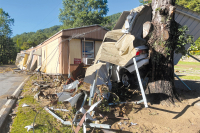Schools feeding more students for free
 Free lunch is becoming a more common phenomenon around Western North Carolina as school systems start adopting a new federal program aiming to increase kids’ access to food in high-poverty areas.
Free lunch is becoming a more common phenomenon around Western North Carolina as school systems start adopting a new federal program aiming to increase kids’ access to food in high-poverty areas.
“There’s a lot of families that may not qualify for free and reduced lunch, might be 40 cents off of meeting that federal income level required, and it’s very expensive if they have several kids they have to buy lunch for, so a lot of times they’ll just pack,” said Allison Francis, director of the child nutrition program for Haywood County Schools. Haywood enrolled in the program last year, when it first became available.
“I think we’re hitting a lot of those kids that may not qualify but could benefit from the program,” said Francis.
Two Haywood County schools — Central Elementary School and Central Haywood High School — offer free breakfast and lunch under the Community Eligibility Provision.
In 2015-16, schools in Macon, Swain and Jackson counties will join the list. Jackson County’s school board recently voted to implement the program in Smokey Mountain Elementary School, Blue Ridge School, Blue Ridge Early College and the School of Alternatives. In Macon, Union Academy and East Franklin Elementary School will participate. And Swain West Elementary will also participate.
The schools’ food service directors are excited to start offering free meals to the students in their poorest schools. They anticipate that the program will take away the stigma from having to sign up as a Free and Reduced Lunch student and get rid of issues with parents turning in the paperwork. Reduced paperwork is also expected to be a benefit on the administrative end.
Related Items
“We’re constantly for the first two months of school doing tons of paperwork,” said Laura Cabe, nutrition director for Jackson County.
“That’s really when I want to be out in the schools,” she added, “especially when we’re doing new things like this, and that will free up more time.”
All that sounds pretty rosy, but there’s a risk to adopting the program.
“It is one of those programs that ‘sounds’ like a real winner but can have dire financial consequences if things don’t go as planned,” said Kim Terrell, nutrition director for Macon County Schools. It’s because of those potential consequences that she waited a year before trying out the program.
Eligibility for the program is based on the percentage of students who directly qualify for free and reduced lunch. That means that they’re part of a food assistance program like SNAP or TANF (Supplemental Nutrition Assistance Program or Temporary Assistance for Need Families), enrolled in Head Start or Pre-K Even Start, or they’re a migrant, homeless or runaway. Schools with at least 40 percent of students who directly qualify can enroll in the program.
But local districts aren’t rushing to sign up all schools at 40 and above. That’s because school districts don’t get complete reimbursement for meals provided through the program, so deciding which schools to enroll is a carefully calculated process.
“The point is just to break even,” Cabe said. “That’s what we want.”
The federal government multiplies the percent of students who directly qualify for free and reduced lunch by 1.6, and the resulting number, up to 100, determines what percentage of the food costs are reimbursed at the free rate. The rest are reimbursed at the paid rate, which is a whole lot less. If the program loses money, then the school system has to pick up the tab.
Cabe is hopeful that the four schools Jackson has selected will have the numbers to make it work. The percentage of students there who directly qualify ranges from 57 to 65 percent, which is pretty high. The magic number — the percentage at which all food costs can be claimed at the free rate — is 62.5 percent.
But schools can decrease their costs by increasing the number of students who eat the meals. That’s what Cabe is hoping to see happen in the Jackson County schools using the program next year. Currently, 27 percent of students eat breakfast at school and 60 percent buy school lunch.
Participation has definitely increased at Haywood County schools using the Community Eligiblity Provision, Francis said. At Central Elementary, about 82 percent of students eat breakfast, and 87 percent buy lunch. That lunch stat is up from 81 percent before Haywood adopted the program.
Numbers have shot up at Central Haywood High as well. Breakfast participation has increased 11 percent, from 55 to 66 percent, and lunch has gone up 9 percent, from 75 to 84 percent.
Francis has nothing but good things to say about the program as it stands now. Paperwork has decreased, more kids are getting food and she hasn’t had to shoulder any increased staffing costs. But both Central Elementary and Central Haywood have direct qualification rates around 60 percent, which means about 96 percent of their costs are reimbursed at the free rate. Francis said she’d be cautious about implementing the program in any more of Haywood County’s schools.
“The rest of our schools are closer to the 50 [percent] range, so the possibility of losing a lot of money at these sites is just too risky,” she said.
Cabe knows it’s a risk, but she’s hopeful of seeing success.
“We’ll see what happens,” she said, “but I’m really confident we can make this work.”
Getting a free lunch
The following schools in The Smoky Mountain News’ coverage area will be offering free breakfast and lunch to all students in the coming school year through the Community Eligibility Provision, a program of the U.S. Department of Agriculture.
Haywood County
• Central Elementary School
• Central Haywood High School
Jackson County
• Blue Ridge Early College
• Blue Ridge School
• School of Alternatives
• Smokey Mountain Elementary School
Macon County
• East Franklin Elementary School
• Union Academy
Swain County
• Swain West Elementary School









